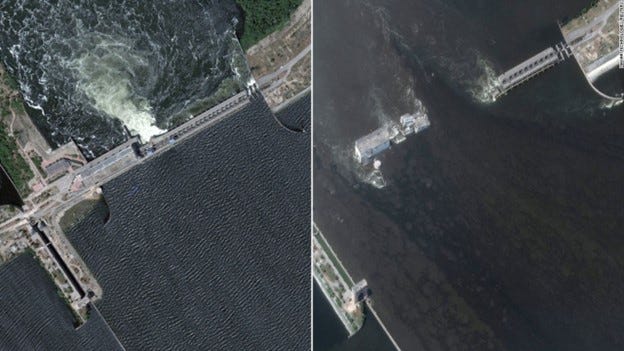Introduction
Managing shared water resources across international boundaries can be a cause of conflict, for example the Grand Ethiopian Renaissance Dam (GERD) [see a previous Substack posted 24th May 2023]. More serious ‘Water wars’ between countries have been predicted over these ‘transboundary’ resources.
Perhaps the nearest we have come to this was when the Kakhovka Dam was blown up in June 2023 during the Ukraine/Russia conflict. Extensive flooding took place afterwards, and there were warnings related to water supply in the region and to supplies to canals that irrigated farmlands. However, we are yet to see one country waging full-scale war on another because of a shared river or lake they want more access to. Generally, there is a balance between conflict and cooperation over shared waters and this balance depends on the circumstances in each case.
Figure 1. The Kakhova Dam (before and after the dam was blown up)
International waters
Around two thirds of the Earth’s surface is covered in water. Most of this water is saltwater, found in the seas and oceans. Freshwater resources make up only 2.5% of the total volume of water on Earth. Of this, only 0.3% is contained in freshwater lakes and rivers. Consequently, access to freshwater lakes and rivers has been a key principle for many societies - settlements have grown up around these resources throughout history to access drinking and irrigation supplies.
Three types of river boundaries that cross or touch the borders of two or more countries can be identified (Figure 2):
Figure 2
(Diagram from Geography Review)
· Contiguous: when a river forms a border between two countries, such as the Shatt-al-Arab River that separates Iran and Iraq. In the summer of 2023, the Dominican Republic said it would close its border with Haiti amid a conflict over access to the Massacre River shared between the two countries. Tensions had grown over the proposed construction of a canal to divert water from the river to irrigate some Haitian farms. The Dominican President feared it would harm farmers in his country.
· Mixed: when a river forms a border and then crosses it, as in the case of the Mekong River, which forms part of the border between Laos and Thailand and then flows through Cambodia.
· Successive: when a river crosses a border and generates an upstream-downstream configuration, such as the Tigris River which flows from Turkey through Iraq. The Nile has several successive countries: for example, Ethiopia, Sudan, and Egypt. Similarly, originating in Germany, the Danube flows southeast for 2,850 km, passing through or bordering Austria, Slovakia, Hungary, Croatia, Serbia, Romania, Bulgaria, Moldova, and Ukraine.
International law
International water law deals with the use and protection of transboundary watercourses. Such international law is made up of agreements (treaties and conventions), and decisions of intergovernmental organisations that are made binding by the signing of treaties. However, there is no such thing as an international water police force enforcing these agreements.
According to the UN’s Food and Agriculture Organisation (FAO), over 3,600 declarations and treaties (bilateral and multilateral) relating to international water resources have been negotiated and signed. Until recently, international water law focused mostly on the navigational uses of a river and generation of hydroelectricity. More recently, river pollution, water sharing, and flood control have become increasingly important in the treaties signed.
There are currently over 300 transboundary freshwater lake and river basins worldwide, but this number is constantly changing as political changes result in new international boundaries. For example, the dissolution of the Soviet Union in 1991, and the 1999 war in the former Yugoslavia, created new states and several new international river basins. On the other hand, the unification of East and West Germany and of Southern and Northern Yemen led to the disappearance of some.
For almost two-thirds of these basins there is no agreement between the countries that share them. Cooperation appears to be the norm, conflict the exception.





